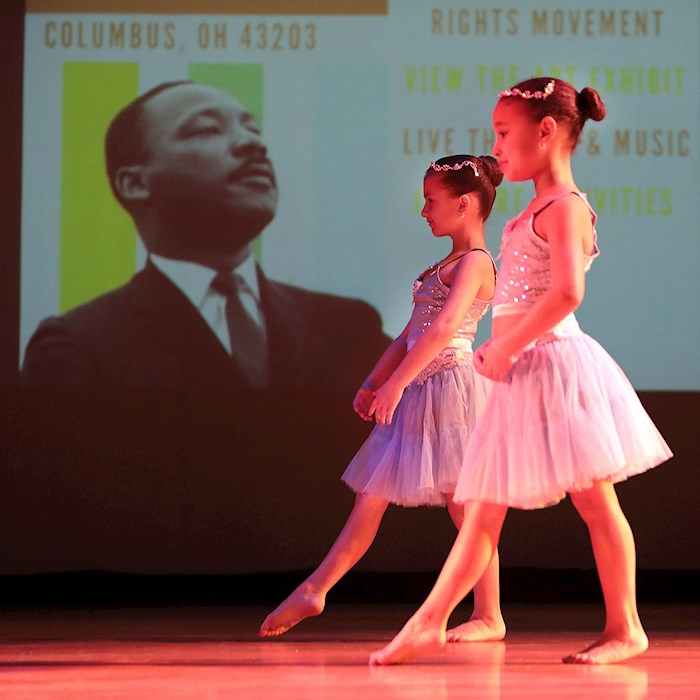The Alchemy of High-Performing Arts Organizations: A Spotlight on Organizations of Color
Published March 10, 2021
This report, published in partnership with The Wallace Foundation, is based on research conducted during August and September of 2020 investigating the elements of successful strategies employed by high-performing arts organizations that primarily serve communities of color.

By Dr. Zannie Voss, Director of SMU DataArts and Dr. Glenn Voss, Research Director of SMU DataArts. Commissioned by the Wallace Foundation.
What lessons can we learn about relevance and resilience from high-performing arts organizations that primarily serve communities of color?
How do they establish and maintain deep connections with the communities they serve and that sustain them, and what are the distinctive challenges they encounter in doing so?
It's free!
Executive Summary
This paper, based on research conducted during August and September of 2020, shares findings from a second phase of research investigating the elements of successful strategies employed by high-performing arts organizations. Phase I, conducted in early 2020, examined the strategies employed by 10 visual and performing arts organizations that financially outperformed others and 10 that once performed poorly but engineered a turnaround. It also explored the conditions in which these strategies appeared to succeed.
Phase II explores whether findings similar to those of Phase I would emerge with high-performing organizations in the performing and community-based arts sectors that primarily serve communities of color, with lower average budget size than those in the initial cohort, and during the COVID-19 pandemic. Despite the pandemic and key differences in organizational characteristics, many of the elements described by leaders of these organizations of color were identical to those that emerged in Phase I while others were depicted quite differently, and several new elements and connections emerged.
As of the writing of this report, bans on large gatherings have prompted the indefinite shuttering of all in-person programs for organizations in many markets, including those that participated in this study. We hope these findings will be helpful to organizations as they work to emerge from the pandemic.
Specifically, in Phase II we examined the following research questions: 1) What are examples of performing arts and community-based arts organizations of color that have financially outperformed others in substantial ways? 2) What kinds of strategies were used to achieve this financial performance? and 3) Were there particular contexts or conditions in which these strategies seemed to be more effective?
To identify high performance on a variety of financial and operating metrics, we analyzed data from over 5,000 organizations around the country to estimate the “highest” feasible performance level an organization might attain under different conditions and with different sets of inputs. This analytical method is called stochastic frontier analysis. Given the same conditions and with the same set of inputs, high-performing organizations come close to achieving the maximum performance that is reasonably possible. In this case, inputs are the characteristics of the organization (e.g., budget size, arts sector, organizational age, square footage, whether it seeks primarily to serve a specific audience demographic, etc.) and the community in which it operates (e.g., median age and income, cost of living, population, number of local arts organizations, etc.). This approach allows us to create a level playing field and focus on organizations that outperform expectations given their context, thereby avoiding the pitfall of equating high performance with larger budget size.
We identified and interviewed leaders of 11 performing arts organizations in the dance, music/orchestra, theater, performing arts center, and multidisciplinary performing arts sectors, as well as 10 leaders of community-based arts organizations (CBOs) in the folk arts, cultural and ethnic awareness, and general arts and culture sectors with a track record of high performance along seven financial and operating metrics in recent years. These 21 organizations each self-identify as primarily serving Black, Indigenous, Hispanic/Latinx, Arab American or Asian American communities through their mission-related work. Their annual budgets ranged from $146,000 to $15 million.
To understand how these organizations achieved high performance, we then conducted interviews with the individuals who lead them. Based on recurring themes that surfaced in the interviews, we built a theoretical model for success, which can be empirically tested in future research.
Throughout the report we share strategies, insights, and advice from successful arts leaders in their own words. The findings from Phase II, while largely consistent with Phase I findings, included some important nuanced differences that are embedded into the descriptions below, and elaborated upon in the full report. We heard that success takes a slow, controlled burn. These leaders recognize that there are multiple steps in the process rather than assume there will be a miracle moment or single action that leads to success. In speaking to their strategies and plans, they described the following elements of a kind of “mental map,” or playbook, linking their strategic choices and decisions to outcomes:
Key Findings

- The cornerstones of high performance appear to lie in the alchemy between community orientation and high-quality programs. According to arts leaders, therein lies the formula for strategic vision, or the organization’s answer to the question, “How will you have created value, and for whom?” An executive director shared: “We have really built a community around outstanding theatre and education programs. Artists want to work here, fans want to come, funders want to support it.”
- Strong cornerstones of a strategic vision lead to the following short-term outcomes: tactical wins that inspire confidence and excitement, a stronger brand, a high-functioning board, and community relationship development and buy-in.
- Environmental factors such as racism, gentrification, lack of access to institutional funding, and the crises of COVID-19 and racial unrest challenge an organization’s ability to achieve short-term gains.
- A number of internal factors moderate or regulate the organization’s ability to translate these cornerstones into positive short-term outcomes, including mission alignment, adaptive capabilities, investments in marketing and fundraising, a multi-year horizon, and a healthy culture that invites participation.
- Short-term outcomes provide a feedback loop that reinforces the cornerstones of strategic vision. They also lead to the intermediary outcome of deeper community and donor engagement, provided the organization continues to invest in relationship-building.
- The deeper relationships then lead to increased revenues from audiences and donors and greater organizational capacity, if the community has the means to elevate its level of support and the organization has equitable access to institutional funding. When organizations operate in environments that are lacking fertile ground for revenue growth and they serve economically disadvantaged communities, they tend to remain relatively small but can achieve financial stability nonetheless. It is important to acknowledge that while some organizations that want to grow face challenges, growth is not a universal ambition and unbalanced growth can be detrimental to long-term health.
- Intermediate outcomes of increased engagement, financial support, and organizational capacity reinforce an organization’s community orientation and advance its ability to achieve high-quality programming standards. They also lead to financial sustainability, provided the organization has discipline. Arts and cultural organizations exist for mission fulfillment, not financial sustainability. Yet the long-term outcome of financial sustainability undergirds the ability to maximize mission success.
It is of note that over 80% of the arts leaders we interviewed in Phase II indicated that their organization is financially solid this year despite the COVID crisis. Their stability may be attributable to the elements that surfaced during our interviews: clear strategies, solid financial starting place heading into the pandemic, strong internal and external relationships, adaptive capabilities, discipline, and alchemy of high standards in the creation of work that is deeply meaningful to the local community. This is not to minimize the difficulties faced by the remaining organizations or to assume that financial stability will endure next year should these difficult extenuating circumstances persist.
This paper is designed to share lessons from interviewees and offer ideas to organizations that seek a path linking strategy and financial sustainability. Phase II interviews reinforced the conceptual model that emerged from interviews in Phase I, with some important nuances. These organizations repeatedly described how their reason for being is rooted in serving their communities’ needs through high-quality art and arts education, and how deeply embedded they are in the fabric of the community. More than half were created to meet unmet needs where no local similar services existed or where there was a lack of opportunities for artists of color. In contrast to leaders interviewed in Phase I of this research, none of the organization leaders mentioned changing consumer preferences or declining participation as obstacles.
The interviews also brought to light challenges faced by these organizations of color that deserve attention. Commonly identified external hurdles unique to these organizations are racism, gentrification, and lack of access to funding, which some see as elements of white supremacy culture. Interviewees noted that when organizations of color seek to grow and serve low-income communities, their ability to expand is inhibited by a participant base that does not have the means itself to generate substantial earned revenue and individual contributions, and by lack of access to corporate and foundation funding at levels equitable to those provided to their peers that do not primarily serve communities of color. The absence of an engine for revenue growth appears to perpetuate critical organizational capacity shortages reflected in burnout, low wages, and insufficient staffing, particularly in the administrative areas that generate revenue. It also limits the number of people that can be served. When organizations of color operate in and serve communities with greater means, they are able to attract sufficient financial resources to fuel growth. However, according to many of those interviewed, they, too, are constrained by comparatively low compensation levels and insufficient organizational capacity, which leads to difficulty recruiting high-caliber talent and burnout for those who stay.
It's free!
Webinar Recording
Featured panelists include Snehal Desai, Producing Artistic Director, East West Players; Demetries Neely, Executive Director & CEO, The King Arts Complex; and Steff Rosalez, CEO, Grandville Avenue Arts & Humanities; moderated by Dr. Zannie Voss, Director, SMU DataArts

A Spotlight on Community Orientation: Chen Dance Center
After nearly everything was lost to a fire in early 2020, Chen Dance Center in New York City perseveres to serve its community through the toughest of times. A story about resiliency, community, and innovation.
A Spotlight on Mission Alignment: Chinese Culture Center of San Francisco
A story about a bold new idea that radically changed the Chinese Culture Center of San Francisco and led to becoming a space where the voices of immigrants, women, and those who are queer, trans, and people of color are heard.


A Spotlight on High-Functioning Board: Dallas Black Dance Theatre
Over 30 years ago, Dallas Black Dance Theatre created a new way to evaluate its board which has helped to codify board composition, policies, and behavioral values for long-term participation.
A Spotlight on Financial Discipline: The King Arts Complex
When Demetries Neely stepped into the role of Executive Director, many stakeholders and others in the community expected The King Arts Complex to close its doors after years of crippling debt. But Neely had other plans.

ABOUT THE WALLACE FOUNDATION
The Wallace Foundation works to support and share effective ideas and practices to foster improvements in learning and enrichment for children and the vitality of the arts for everyone. Its objectives are to improve the quality of schools, primarily by developing and placing effective principals in high-need schools, promoting social and emotional learning in elementary school and out-of-school-time settings, expanding opportunities for high-quality summer learning, reimagining and expanding access to arts learning, and building audiences for the arts. The Foundation seeks to generate knowledge and insights from these efforts to enhance policy and practice nationwide. For more information and research on these and related topics, please visit the Foundation’s Knowledge Center at wallacefoundation.org.
ABOUT SMU DATAARTS
SMU DataArts, the National Center for Arts Research, is a joint project of the Meadows School of the Arts and Cox School of Business at Southern Methodist University. SMU DataArts compiles and analyzes data on arts organizations and their communities nationwide and develops reports on important issues in arts management and patronage. Its findings are available free of charge to arts leaders, funders, policymakers, researchers and the general public. The vision of SMU DataArts is to build a national culture of data-driven decision-making for those who want to see the arts and culture sector thrive. Its mission is to empower arts and cultural leaders with high-quality data and evidence-based resources and insights that help them to overcome challenges and increase impact. To work toward these goals, SMU DataArts integrates data from its Cultural Data Profile, its partner TRG Arts, and other national and government sources such as Theatre Communications Group, the National Endowment for the Arts, the Census Bureau, and IRS 990s. Publications include white papers on emergence from the COVID-19 crisis, culturally specific arts organizations, protecting arts organizations through downturns, gender equity in art museum directorships, working capital and the resiliency of BIPOC organizations, and more. SMU DataArts also publishes reports on the health of the U.S. arts and cultural sector and the annual Arts Vibrancy Index, which highlights the 40 most arts-vibrant communities around the country.